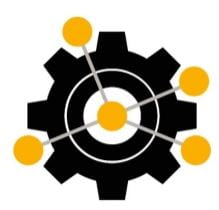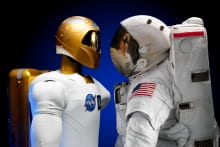Category: Workers and Technology
Science Fiction in Work: New Technologies in the Workplace
By: Keaton Fletcher
In a recent article, CNN highlighted seven ways in which technological advances are potentially changing the way we work. For example, humans are generally pretty terrible at cybersecurity. Many companies have started to use biometric authentication (e.g., iris scanning, fingerprint scanning, or facial recognition) to provide workers access to computer terminals. Hospitals have also started using this technology to protect medications and patient files. Some companies, such as Three Square Market, have started optional programs that allow employees to have a microchip embedded under their skin that acts as their ID badge.
Beyond simple technological innovations for cybersecurity, many companies are turning toward artificial intelligence (AI) to help workers perform better. In healthcare, for example, AI programs have been shown to complete a task that normally takes radiologists 45 minutes (determining blood flow and the volume of cardiac muscles) in a matter of seconds. But AI is not just limited to simple data processing. AI-CDß an AI robot used by McCann Worldgroup Japan, is used as a creative director for television ads.
AI has also made its way into the world of pop music, changing the careers of songwriters in addition to the soundscape on the radio. In a recent podcast episode, musicologist Nate Sloan of Fordham University, and songwriter Charlie Harding, interview songwriter Taryn Southern about her use of AI in songwriting. Together they discussed the multitude of AI programs available as tools to assist songwriters (e.g., Aiva, Flow Machines, Amper, and Nsynth) including the benefits and drawbacks. In a musical Turing Test, Nate and Taryn listened to six pairs of song clips: one written entirely by a human and the other written with the help of AI. The differences were hard to hear, with AI-based music often slightly more complex than human-only music. Both Taryn and Nate found themselves stumped more than once. The hosts acknowledged that in its current form, AI music is either a good tool in a songwriter’s belt or is a replacement for songwriters who are only writing stock music.
Another major area of technological advance is robotics. In a podcast episode, Pamela Gay, Director of Technology and Citizen Science for the Astronomical Society of the Pacific, and Fraser Cain, founder of The Universe Today and director of Cosmoquest, discussed the use of robots on the International Space Station. Specifically, they pointed out two semi-autonomous robots: Dextre and Robotonaut 2 (R2). Dextre is a large set of robotic arms that can either be controlled directly by astronauts or can run autonomously on pre-programmed tasks. It helps complete dangerous but relatively time-consuming and mundane repair activities on the outside of the space station. R2 is a humanoid robot that is being tested inside the ISS in its ability to take over routine, mundane tasks that require human-level dexterity.
Certainly, technological advances are making leaps and bounds. As we navigate the coming changes in the workplace, it will be critical to understand how humans interact with technology, and how technology changes the experience of work itself.
Back to the Future: How Current Technological Changes Are Nothing New
By: Keaton Fletcher
In a recent podcast, Peter Grumble of Mckinsey Global Institute spoke with Susan Lund (a partner at McKinsey) and Richard Cooper, Maurits C. Boas Professor of International Economics at Harvard University, about the concerns regarding the changes advances in technology may bring about in the workforce. To answer this question, Lund and Cooper look backward toward other periods in history in which major technological advances greatly disrupted the workforce. Every time a new technology is developed, many existing jobs are destroyed, but more jobs, often many that were never needed or possible, are created. Lund and Cooper offer the creation and subsequent automation of development of the Ford Model T. As automobiles became more popular, the need for carriage makers and related services declined, but a host of new jobs both directly related to automobile production and maintenance (e.g., gas station attendants, car manufacturers, mechanics) and indirectly related (e.g., tourism) blossomed. Even as machine-based productivity of Model Ts increased the number of cars made from roughly eight cars per worker to about 21 cars per worker, Ford did not see a decreased workforce. In fact, as productivity increased, the price of the Model T decreased, which drove up demand for the Model T, ultimately leading to an increase in the workforce, despite the automation of much of the individual worker’s job.
Looking at the advent of the personal computer, Lund and Cooper estimated that about 3.5 million jobs were lost because of the introduction of this technology into the workplace. However, about 19.3 million jobs were estimated to be made possible or necessary because of this new technology. The difficulty with viewing the current situation in this perspective, they argue, is that the loss of jobs feels tangible and is clear, with both statistical figures and emotional personal anecdotes to make this loss salient. The potential increase in jobs, however, is much more difficult to comprehend because many of these jobs do not exist in any form yet.
What also makes this change particularly daunting is the need for new skills. Although technology can help reduce the barrier to entry for many jobs (e.g., barcode systems reducing the need for mental math to be an effective store clerk), it can also increase the need for unique and varied skills, many of which are related to technology. Lund and Cooper point toward estimates that roughly 375 million workers globally may need to entirely switch occupations, with even more needing to update their skill sets. This makes the rapid and effective training and re-training of middle-aged adults particularly necessary moving forward. Lund and Cooper point toward the U.S. Armed Forces as an example of successfully re-training individuals who, after a career in the Armed Forces, need to learn new skills to take on a new civilian occupation.
In a separate podcast, Matthew Taylor (Chief Executive of the Royal Society for the Encouragement of Arts, Manufactures, and Commerce) and James Manyika (chairman of the McKinsey Global Institute) discussed how to ensure people find meaning and are able to do “good work” in the modern economy. As Land and Cooper pointed out, the workweek has shortened from about 60 hours per week 125 years ago to roughly 37.5 hours per week today, along with paid vacations and holidays. Taylor points toward increases in autonomy and flexibility as methods of improving life quality, even as wages remain stagnant. Taylor suggests offloading non-rewarding work, the drudgery, onto machines and robots, freeing up humans to pursue meaningful work that gives them a sense of mastery and autonomy.
Although many workers may be worried about losing their jobs or needing to be retrained and many others may be excited by the prospects of more meaningful work by way of the proper use of technology, Land and Cooper both warn that change will likely not happen overnight. Although technology is developing rapidly and change is coming, there is, thus far, no evidence that organizations are adopting new technology any faster than they did before.



